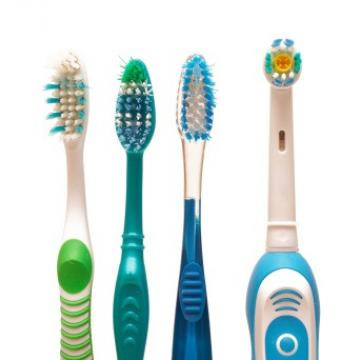Newsletter - October 2013 Issue

Your toothbrush is the most important item in your oral health toolkit. But with such a wide variety of toothbrushes available, how do you choose the brush that's best for you? And once you've made your selection, how do you care for and clean your toothbrush? Learn how to improve your oral health care habits by properly selecting and caring for your toothbrush.
What should I look for when choosing a toothbrush?
The best toothbrushes have a long, wide handle that facilitates a firm grip. The toothbrush head should be small enough to reach all areas of the mouth, with soft nylon bristles that won't hurt the gums.
Should I use an electric toothbrush?
Electric toothbrushes, which use an oscillating or rotary motion to clean the teeth, are beneficial because they can cover a large area of the mouth faster than a manual toothbrush. They're especially well-suited for those with braces, those who need extra motivation to brush, and those who have difficulty operating a manual toothbrush due to age, disability, or other factors.
If you use an electric toothbrush, avoid pressing down too hard; instead, use light force and slow movements, letting the brush do the work for you. Those using an electric toothbrush for the first time may experience slight bleeding from the gums, which will subside over time. Children age 10 and younger should be supervised while using an electric toothbrush.
How often should I change my toothbrush?
Old toothbrushes with worn and frayed bristles will not clean your teeth effectively, and they also may harbor harmful bacteria. You should change your toothbrush-or brush head, in the case of an electric toothbrush-every three to four months. However, if you get sick with a cold or flu, you will need to change your toothbrush as soon as the illness begins and again once the illness has subsided. This will help to get rid of any germs and bacteria on your toothbrush.
How can I keep my toothbrush clean?
Wash your hands both before and after brushing to avoid transferring bacteria and food particles to your toothbrush. After brushing, rinse your toothbrush thoroughly to remove excess toothpaste and other debris, and soak the brush in antiseptic mouth rinse to eliminate any lingering bacteria. Remember: Never share toothbrushes, as this habit can lead to the transmission of cold and/or bacteria.
How should I store my toothbrush?
Store your toothbrush upright and left it air dry before using it again. Microorganisms are more likely to grow in a moist environment, so don't cover your toothbrush or store it in a closed container. Because bacteria can travel easily from brush to brush, don't store your toothbrush in the same container as some else. Finally, keep your toothbrush as far away from the toilet as possible to avoid contamination from the airborne bacteria that are released with each flush.
Talk to your dentist if you have questions about choosing or caring for your toothbrush. No matter which kind of toothbrush you have, make sure to brush your teeth for two minutes twice a day and visit the dentist regularly to maintain good oral health.
For more information or to book your appointment, please email us at flossopphy@yahoo.com or call us at 817-466-9972.
Have a great day!
